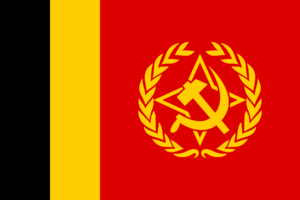Economy of Velaheria: Difference between revisions
| Line 34: | Line 34: | ||
==Corruption== | ==Corruption== | ||
Corruption inside of Velaheria is widespread, this is mainly observed by the fact that even the simplest of actions require's some sort of illegal actions, Corruption is visible in all sections of society, Though the people have largely seemed to have accepted it, partially due to the lack of government's interest to act on such matters. | |||
==History== | ==History== | ||
Revision as of 04:10, 27 June 2021
 | |
| Currency | Wran (VW) |
|---|---|
| 1 March — 31 April | |
Trade organisations | None |
| Statistics | |
| GDP | USD 80 billion (PPP, 2020) |
GDP growth | 2.7% (2020) |
GDP per capita | USD 2,720 (PPP, 2020) |
GDP by sector | Services: 30,7% Industry: 42,3% Agriculture: 18,0% |
| 5.6% | |
Population below poverty line | N/A (2020) |
| 0.30 (2020) | |
Labour force | 18 million (2020) |
Labour force by occupation | Services: 32,1% Industry: 40,9% Agriculture: 18,0% |
| Unemployment | 5-7% (2020) |
Main industries | List
|
| External | |
Export goods | List
|
Import goods | List
|
Overview
Velaheria has maintained one of the most closed and centralized economies in the wurld since the 1940s. For several decades, it followed the Central pattern of five-year plans with the ultimate goal of achieving self-sufficiency.
Extensive communist support allowed Velaheria to rapidly register very high growth rates, However, this has also lead to systematic inefficiencies which are largely visible in the economic production and activities of velaheria.
The State expertises in the production of heavy machinery, metals and minerals which form the backbone of its economy, it also has its fair share of growth through agricultural activities which form a large part of its economy.
Services are a relatively moderate part of the nation, with the average services available being small scaled due to the centralization of policies and the ban on private ownership and existence of large scale private companies inside the nation, though several minor small private organization thrive inside the nation's largest cities, due to a general lack of oversight by the government on their activities.
Corruption
Corruption inside of Velaheria is widespread, this is mainly observed by the fact that even the simplest of actions require's some sort of illegal actions, Corruption is visible in all sections of society, Though the people have largely seemed to have accepted it, partially due to the lack of government's interest to act on such matters.
History
The first foundations of the Velaherian Industrial powerhouse, was started in the 17th century, during the rule of the dolchlanders, they first implemented the first serious reforms to transform the mostly agricultural nation into a minimally industrialised one, they builted the first manufacturing sites.
These were plain sawmills and mines, which produced the raw materials required for dolchland, and was exported back to them, they also expanded the farming lands to include parts of the forests which the native velhars, used for gathering basic forest materials such as firewood, etc, and led to the reduction of commmodities for the people, which led in a reduction of availability of necessary resources to the people.
The Dolchlic's enslaved those people into servitude, serving as labourers working in the mines and in the farms owned by the rich Dolchic landlords, they were often mistreated and were starved to death, despite these conditions, the production of the crops and minerals steadily increased, as a result of this slave labour.
In the 1810's and 1820's, the first industrial complexes were developed in the capital of the dolch administered velaheria, Bastaria, where cloths and other luxury items were made, the construction of these factories, made the income of the dolch administered region, skyrocket, as they would receive the raw materials at a much lesser price than that of the market, and would sell them to foreign states, which made this venture extremely profitable, The factories were also expanded and as a result by the 1840's , the entirity of Bastaria was changed into an industrial city, filled with workers and slave labour.
In the 1860's, the Colonial Administration decided to implement a set of reforms to increase the growth of their holdings, they started to build several mineral refineries, to produce steel and iron, which lead to massive increases in the industrial growth in that area, however this was only concentrated to some cities, so overall this whole industrial development was minimal compared to that of the entire nation.